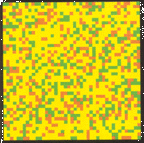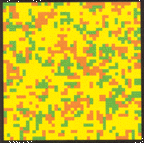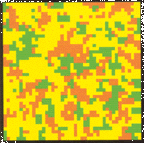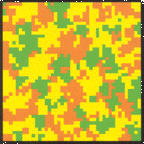Ethics Decision Theory Simulations
by Joseph Schreiner
What Are All These Multi-Colored Checkerboards?
These checkerboards are a specialized spatial representative of the Iterated Prisoner's Dilemma.
Most Iterated Prisoner's Dilemmas (IPD) consist of each strategy competing against all other strategies during a simulation. However, this may not best correspond to real-life situations. In the real world, almost all of our encounters are with neighbors. There are billions of people with whom we will have no encounters. So a more realistic simulation is encountering only neighbors (spatial).

This spatial format is also a more reasonable representation of the evolutionary process. When two agents have repeated encounters, where one makes significant gains, and the other significant losses, then the loser is dropped from evolutionary competition, and the winner replaces it.
The spatial format also represents cultural diffusion. Each cell may be a person or tribe. Each cell has a different strategy toward encounters. When a cell has a consistently defective strategy, and a neighbor has a consistently effective strategy, the poor-performing cell adopts the strategy of its successful neighbor.

In the checkerboard IPD, each agent (cell) has multiple encounters with its four neighbors (fewer neighbors if it is at an edge or corner). If an agent/cell consistently loses with respect to a more successful neighbor, then that cell acquires the strategy of the winning neighbor.
There are many variations of the spatial IPD, far too many to discuss here. For your visual pleasure, I ran a variety of spatial IPD's, and present the results on this site. Each spatial IPD has four states: the initial/random state, a "final" state, and two intermediate states. I created these spatial IPD's with my own Visual Basic program on a Windows 98 machine.

A cell may have one of three simple strategies: cooperate 90% of the time (green), cooperate 50% of the time (yellow), and cooperate 10% of the time (red). These cells have no memory, so none are capable of a Tit-for-Tat strategy. Each cell merely cooperates or defects with its neighbors at a fixed rate.

Most spatial IPD's without memory result in a rout by either the Red or Green cells, depending on the encounter payoff matrices. But a few spatial IPD's result in interesting patterns, and I present them on these pages.